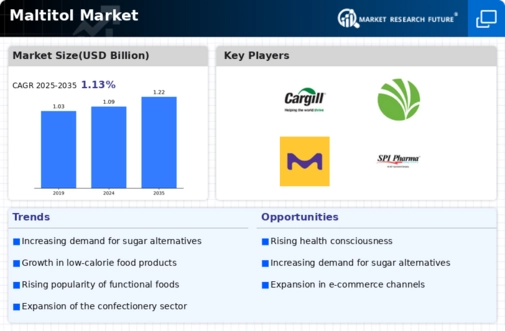Market Growth Projections
The Global Maltitol Market Industry is projected to experience steady growth, with estimates indicating a market value of 1.09 USD Billion in 2024 and a rise to 1.22 USD Billion by 2035. The compound annual growth rate (CAGR) is anticipated to be 1.03% from 2025 to 2035, reflecting a gradual yet consistent increase in demand for maltitol. This growth trajectory suggests that the industry is adapting to changing consumer preferences, particularly towards healthier alternatives to sugar. As more manufacturers recognize the potential of maltitol in their product formulations, the market is likely to expand, driven by both consumer demand and regulatory support.
Consumer Awareness and Education
The Global Maltitol Market Industry is benefiting from increased consumer awareness and education regarding the advantages of sugar alternatives. As consumers become more informed about the health implications of sugar consumption, they are more likely to seek out products containing maltitol. This heightened awareness is leading to a greater acceptance of maltitol in various food applications, from candies to baked goods. Manufacturers are responding by enhancing product labeling and marketing strategies to highlight the benefits of maltitol, thereby attracting health-conscious consumers. This trend suggests a potential for continued growth in the industry as education efforts align with consumer preferences for healthier food choices.
Rising Demand for Sugar Alternatives
The Global Maltitol Market Industry is experiencing a notable increase in demand for sugar alternatives, driven by a growing awareness of health and wellness. Consumers are increasingly seeking products that offer lower calorie options without sacrificing taste. Maltitol, as a sugar alcohol, provides a sweetening solution that is lower in calories compared to traditional sugars. This trend is reflected in the projected market value of 1.09 USD Billion in 2024, indicating a robust consumer shift towards healthier dietary choices. As more food and beverage manufacturers incorporate maltitol into their products, the industry is likely to expand further, catering to the evolving preferences of health-conscious consumers.
Health Benefits and Low Glycemic Index
The Global Maltitol Market Industry benefits from the health advantages associated with maltitol, particularly its low glycemic index. This characteristic makes maltitol an appealing choice for individuals managing diabetes or those seeking to control blood sugar levels. As health awareness continues to rise, consumers are gravitating towards products that do not spike insulin levels. The increasing incorporation of maltitol in diabetic-friendly products is likely to drive market growth, as it aligns with consumer demands for healthier options. This trend indicates a potential for sustained growth in the industry, as more manufacturers recognize the benefits of maltitol in catering to health-conscious consumers.
Regulatory Support for Sugar Substitutes
The Global Maltitol Market Industry is positively impacted by regulatory support for sugar substitutes, which encourages the use of low-calorie sweeteners like maltitol. Various health organizations and government agencies endorse the consumption of sugar alternatives to combat rising obesity rates and related health issues. This regulatory backing not only legitimizes maltitol as a safe ingredient but also promotes its adoption in various food products. As regulations evolve to support healthier food options, the market for maltitol is expected to grow, providing opportunities for manufacturers to innovate and expand their product lines. This supportive environment may contribute to the projected CAGR of 1.03% from 2025 to 2035.
Expansion of the Food and Beverage Sector
The Global Maltitol Market Industry is significantly influenced by the expansion of the food and beverage sector, which is increasingly incorporating maltitol as a key ingredient. This growth is attributed to the rising popularity of low-sugar and sugar-free products, particularly in confectionery and baked goods. As the industry adapts to consumer preferences, maltitol serves as an effective sweetener that enhances flavor while maintaining lower caloric content. The market is projected to reach 1.22 USD Billion by 2035, reflecting the ongoing integration of maltitol in various food applications. This trend suggests a promising future for maltitol as a staple ingredient in the evolving food landscape.





